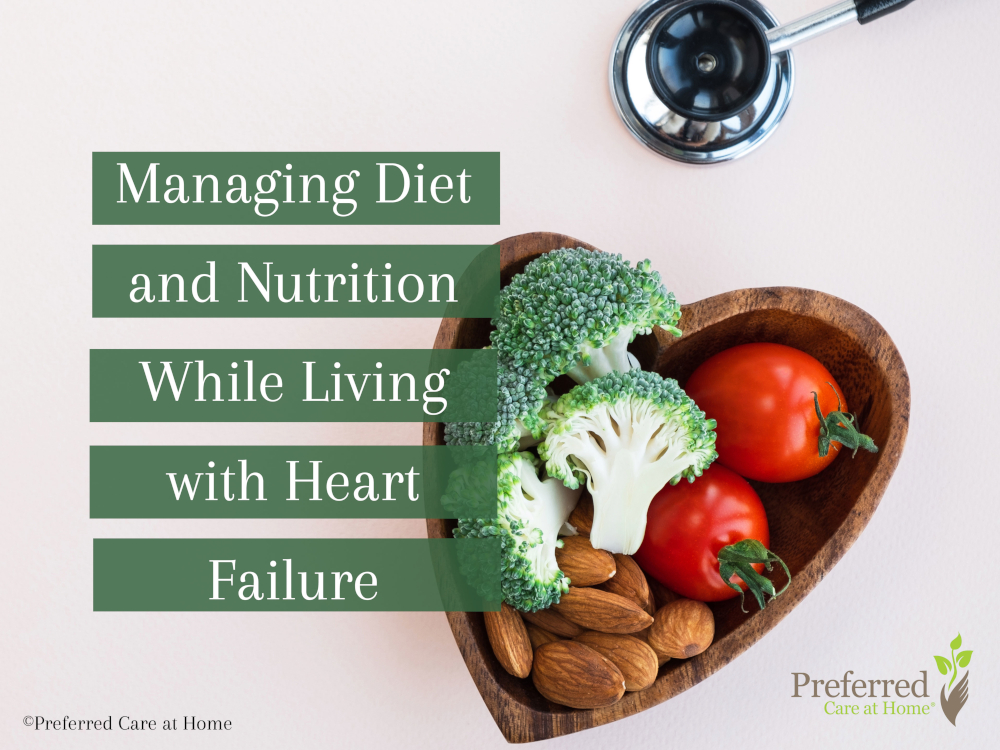Managing Diet and Nutrition While Living with Heart Failure
Published April 4, 2020 by R. Bradley Robinson, M.D. in Senior Health & Wellness

For over 5 million Americans, living with heart failure is a daily reality that requires significant attention to one’s medications, daily weight, and nutrition. Managing one’s diet is particularly important as this can highly impact both short term and long term heart health. Let’s take a closer look at how nutrition relates to heart failure, then explore some tips for better eating for those affected by this disease.
What is Heart Failure and Why is Nutrition so Important?
On a simple level, heart failure is when the heart fails to pump blood as it normally should. There are different subtypes of heart failure and many causes, but a poorly functioning ‘pump’ is the basic problem. When this happens, there can be problems with other organs, for example, the kidneys, lungs, and liver. This occurs either because the heart cannot pump blood to these organs as effectively or because blood cannot flow easily through the heart but rather builds up pressure in the veins that return blood to the heart. In the latter case, this may cause shortness of breath (when this occurs in the lungs), affect liver function (when this occurs in the liver), or lead to leg swelling. Heart function is influenced by how much fluid is in the cardiovascular system. As such, your physician will often prescribe medications to optimize your fluid status in order to help your heart function most effectively.
In the short term, the importance of diet and nutrition centers on one’s sodium intake. When an individual consumes too much sodium, this can lead to fluid retention and overwhelm the heart pump, thereby leading to acute heart failure decompensation that may require admission to the hospital. In the long term, the main focus of nutrition is on a heart-healthy diet that promotes healthy cholesterol levels.
Nutrition Tips with Heart Failure
- Know your Numbers. It is important for most individuals with heart failure to keep track of sodium intake, fluid intake, and daily weight. Choose the method that works best for you. While pen and paper is certainly an option, be sure to check out the app store on your smart phone for easy-to-use digital trackers.
- Sodium: While there are no strict guidelines, sodium intake is often restricted to no more than 3 grams or 3,000 mg per day. Discuss your specific goal with your physician, then be sure to stay on track.
- Fluid Intake: This will also be personalized for each individual in coordination with a physician. This not only includes beverages alongside meals, but also fluid when taking medications, fluid from melted ice cubes, etc.
- Weight: Changes in your daily weight can be the first sign of a change in your fluid status. Even an increase by a couple of pounds can signal that you may be developing fluid overload. Talk to your physician about when he or she would like to be contacted about a change in your weight so that changes in medication or other treatment may be considered.
- Eliminate or Restrict Alcohol. Alcohol can have a negative effect on the function of the heart. In fact, some cases of heart failure are a direct result of alcohol consumption. In this case, it is important to completely refrain from alcohol use. For those with heart failure of other causes, talk with your physician about how much alcohol (if any) is safe to consume.
- Be Aware of Hidden Sodium. Eating out at restaurants can be difficult for individuals with heart failure. Seemingly healthy food choices may be loaded with sodium, for example, many salad dressings or soups. As such, it is important to be aware of these sources of sodium and try to avoid them. Ask the server about low sodium options or entrees that are baked instead of fried. Millions of Americans require a low sodium diet, and thus many restaurants will offer low sodium options. However, most fast food locales are an exception and should be avoided as a low sodium option is nearly impossible.
- Choose Fresh or Frozen Vegetables. Fresh or frozen vegetables are lower in sodium as compared to most canned vegetables. Always check the label for sodium content, and pay attention to “serving size per can/bag” as this may multiply the amount of sodium. For those wanting canned vegetables, there are some low or no-sodium options, just be sure to look at the nutrition label.
- Use alternative seasonings such as spices or herbs. Restricting salt can make it difficult to prepare appetizing meals, but there are other ways to bring out flavor without using so much sodium. Use a recipe website to come up with flavorful dishes. All Recipes is one of our favorites due to the peer rating system. Just like you may use Yelp or Trip Advisor for reviews when choosing a restaurant, peer ratings are important for selecting recipes. Keep an eye out for the highly-rated recipes. There is strength in numbers!
Navigating a Heart Failure Nutrition Plan Together
If you find it difficult to stick with a nutrition plan or prepare savory meals, there are individuals who can help. Reach out to your physician and perhaps schedule a meeting with a registered dietician. He or she can help you develop a nutrition plan that best fits your preferences, and the cost may be covered by your insurance.
Living with heart failure is challenging, but with these resources, consider taking a fresh look and a new approach to your diet and nutrition plan, all toward living a healthier and happier life.
If you have questions about senior home
care services or if you want to start care:
Related Posts

November 9, 2023
Celebrating Robert Louis Stevenson’s Birthday: Exploring the Legacy of ‘Jekyll & Hyde
Ashly Luckose, Esq.

November 3, 2023
Visiting Grandparents During the Holidays: Preparing Kids with Books on Aging
Gina Farmer

October 19, 2023
Preventing Osteoporosis: Essential Tips for Stronger Bones Post-Menopause
R. Bradley Robinson, M.D.
Helping seniors age in place, with dignity & grace.